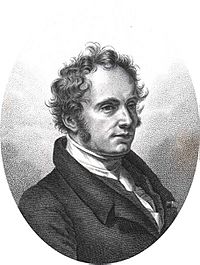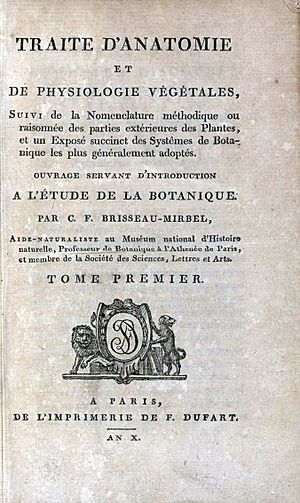Charles-François Brisseau de Mirbel facts for kids
Quick facts for kids
Charles-François Brisseau de Mirbel
|
|
|---|---|

Portrait of Charles-François Brisseau de Mirbel
|
|
| Born | 27 March 1776 Paris
|
| Died | September 12, 1854 (aged 78) Champerret, Paris
|
| Nationality | French |
| Known for | cytology |
| Scientific career | |
| Fields | botanist and politician |
Charles-François Brisseau de Mirbel (born March 27, 1776 – died September 12, 1854) was a French scientist who studied plants. He was a pioneer in understanding plant cells. He also had a role in government.
Contents
Early Life and Discoveries
Charles-François was born in Paris, France. When he was 20, he started working at the French National Museum of Natural History. This is where he began looking at plant parts very closely using a microscope.
Founding Plant Cell Science
In 1802, Mirbel wrote an important book called Traité d'anatomie et de physiologie végétale. This book helped start the study of plant cells (cytology). It also helped create the study of plant histology (how plant tissues are organized) and plant physiology (how plants work).
He suggested that all plant tissues come from a basic supporting tissue called parenchyma. A big discovery he made in 1809 was that each plant cell is surrounded by a continuous outer layer, or membrane. This idea is still very important in cell biology today.
Working for Napoleon
In 1803, Mirbel became the manager of the gardens at Napoleon's Château de Malmaison. There, he continued to study how plant tissues are built and how plant parts grow. He also studied and described a type of plant called Marchantia, which is a kind of liverwort.
His work helped him become a member of the French Academy of Sciences in 1808. He also became the head of the botany (plant science) department at the Sorbonne. In 1815, he put all his studies on plant tissues into another book called Eléments de physiologie végétale et de botanique.
Later Career and Recognition
After a change in the French government, Mirbel's friend, Élie Decazes, offered him a high-level government job. However, when the government changed again in 1829, Mirbel left politics.
He went back to the National Museum of Natural History. He became the head of the famous Jardin des Plantes in Paris. Later, he became the Director of Culture for the museum. In 1837, Mirbel was chosen as a foreign member of the British Royal Society in London, which is a very respected science group.
Personal Life and Legacy
In 1823, Mirbel married Lizinska Aimée Zoé Rue, who was a French artist. He passed away in Champerret, France, in 1854.
To honor his contributions to science, a plant genus called Mirbelia and a type of orchid called Dendrobium mirbelianum were named after him.
Selected Works
- Traité d'anatomie et de physiologie végétale, 1802
- Histoire naturelle, générale et particulière de plantes, 1802–1806
- Exposition de la théorie de l'organisation végétale, 1809
- Éléments de physiologie végétale et de botanique, 1815


